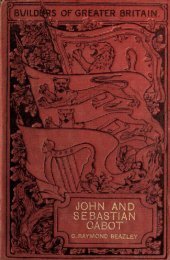st. john of damascus (676-749 - Cristo Raul
st. john of damascus (676-749 - Cristo Raul
st. john of damascus (676-749 - Cristo Raul
You also want an ePaper? Increase the reach of your titles
YUMPU automatically turns print PDFs into web optimized ePapers that Google loves.
"<br />
"<br />
1 82 ST. JOHN OF DAMASCUS.<br />
middle <strong>of</strong> a sentence. The definition given<br />
is that he is a rational animal, liable to death, and<br />
capable <strong>of</strong> intelligence and knowledge."<br />
His bodily<br />
nature consi<strong>st</strong>s <strong>of</strong> four elements :<br />
blood, phlegm,<br />
yellow bile, and black bile. 1 The seats <strong>of</strong> these<br />
humours are then described, and the effects observed<br />
from the preponderance <strong>of</strong> one or other <strong>of</strong> them.<br />
<strong>of</strong> man<br />
Traces <strong>of</strong> these opinions, as we are aware, sur<br />
vive in our own language. When we speak <strong>of</strong> a<br />
man as sanguine, choleric, melancholy, or phleg<br />
matic, we are <strong>of</strong> course embodying the old ideas<br />
expressed by those words; ju<strong>st</strong> as, when we<br />
describe a person as humorous, or humoursome, or<br />
<strong>of</strong> a good or bad temper (that is, blending or com<br />
bination <strong>of</strong> these humours), we are unconsciously<br />
employing terms <strong>of</strong> ancient medical science. An<br />
account <strong>of</strong> the noble<strong>st</strong> part <strong>of</strong> man s body, the head,<br />
is then begun. But the text is in such a mutilated<br />
condition that it is not easy to extract much meaning<br />
1<br />
In the "De Fide Orthodoxa," ii. 12, the same di<strong>st</strong>ribution<br />
is made, with an additional comparison <strong>of</strong> them to the four<br />
cosmical elements. The black bile answers to earth, as being<br />
dry and cold ; the phlegm to water, which is cold and moi<strong>st</strong> ;<br />
the blood to air, which is warm and moi<strong>st</strong> ;<br />
and the yellow<br />
bile to fire, which is hot and dry. The four seasons, it will be<br />
remembered, were also made analogous to them, as also the four<br />
periods <strong>of</strong> human life. Besides Chaucer s Doctour <strong>of</strong> Phisike,<br />
who<br />
(<br />
Knew the cause <strong>of</strong> every maladie,<br />
Were it <strong>of</strong> cold, or hote, or moi<strong>st</strong>e, or drie,<br />
And wher engendred, and <strong>of</strong> what humour,"<br />
Burton maybe cited as illu<strong>st</strong>rating this subject :<br />
Melancholy" (ed. 1861), p. 93.<br />
"Anatomy <strong>of</strong>
















